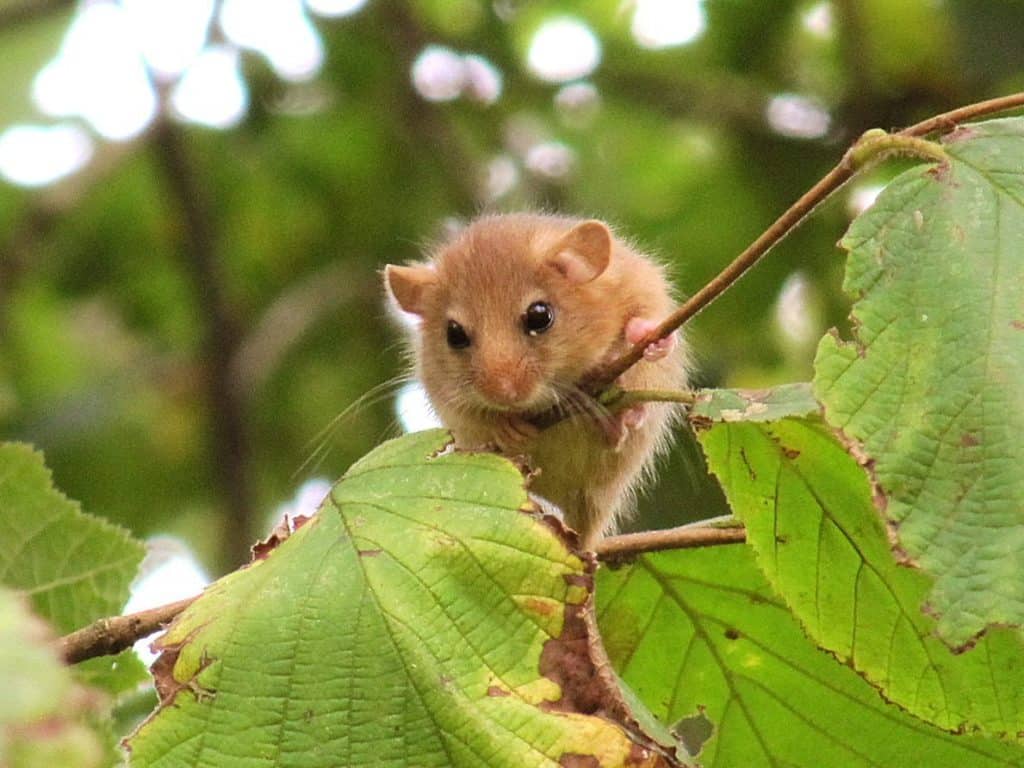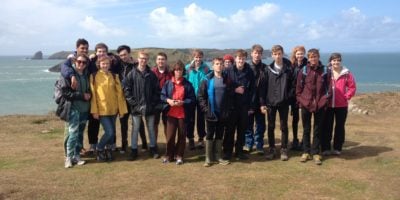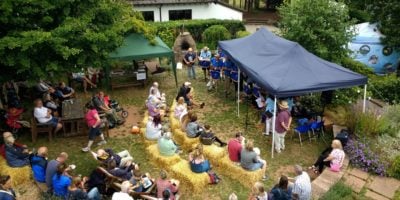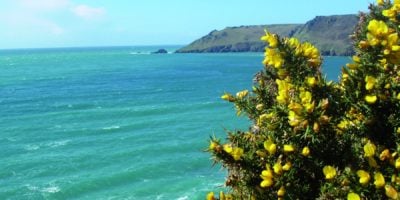Slapton Ley is the largest natural lake in the south west. The lake is separated from the sea by a shingle beach. Woodland, Reedbeds and Fen surround the lake.
Look for wildflowers on the shingle ridge during the summer, including Yellow Horned-poppy and Vipers Bugloss. The nature reserve is the only place in Britain where you can find Strapwort on the lake shore.
You can hear and occasionally see Cetti’s warbler all year round. Slapton Ley is an important staging post for wintering and passage birds including Swallows. If you are lucky you might catch a glimpse of badgers, otters, dormice and bats or join one of our events to find out more. You may also see some of the 250 species of lichen and 2000 species of fungi, 29 of which have been described as new to science.

Key Species
Slapton Ley National Nature Reserve is home to a huge diversity of wildlife owing to its variety of habitat types, from open water to scrub, grassland and woodland. This, coupled with intensive study by naturalists for over half a century, means the number of species recorded here is very large indeed. Many of these species are too small, rare, or located in inaccessible locations, so the chance of seeing them is low. There are, however, many amazing species that you are likely to encounter on a visit to the Slapton Ley. Some you can observe from the nature trail, while others you stand a greater chance of seeing by coming along to one of our many events. You can learn about birdsong on our Dawn Chorus Walk, get a hands-on experience of bird ringing on our Bird in the Hand event and see a range of bats feeding in different habitats on our Bat Watch.
Cetti’s warbler – Cettia cetti
This bird has been spreading North West across Europe from the Mediterranean since the 1940s, arriving in the UK in the 1960s with first proven breeding in Devon in 1975. As a non-migrant insect eating bird, it can suffer severe population declines in hard winters, but because of the relatively mild climate of South Devon, the Slapton Ley population usually remains stable at between 35 and 45 breeding pairs. These high numbers mean that the population at Slapton Ley is classified as ‘nationally important’, making it one of the best places in the country to see this bird.
One of the best places to see this bird is at Slapton Bridge and along the Nature Trail; however, while it’s fairly common here, it is a notoriously shy bird and is almost always heard before it is seen – listen out for its distinctive loud and explosive burst of warbles
Cirl bunting – Emberiza cirlus
The cirl bunting can be found throughout much of Europe, breeding in England as far north as Cumbria by the mid-1930s. Changes in agriculture, specifically the post-war intensification of agriculture, brought about a rapid decline to the extent that just 118 pairs were present in 1989 with 96% found in South Devon.
Conservation work carried out by the RSPB and other conservation organisations has helped this species increase in numbers and range. Their work has involved working with landowners to encourage them to manage their land less intensively, as well as a successful reintroduction project in 2006, with the help of the Whitley Wildlife Conservation Trust. At Slapton Ley, we manage a mixture of arable and pasture for cirl buntings; they require protein-rich insects, particularly grasshoppers, during the summer to rear their young, but switch to cereals and seeds in the winter, when insects are scarce. They also need tall, bushy hedges to nest in – we have these three important components in close proximity, making our land at Loworthy the perfect habitat.
While there is no public access to Loworthy, you can see Cirl buntings in farms and hedges around Slapton, Torcross and Strete. Listen out for their rattling song, which they usually give from a prominent place, like a tall tree of the top of a hedge.
Great Crested Grebe – Podiceps cristatus
The great crested grebe is an attractive waterbird with an elaborate courtship display, which it has become famous for. This species first nested on the ley in 1973 and its breeding population has fluctuated from year to year depending on the availability of the fish upon which it feeds. They nest in dense stands of reeds and when the chicks have fledged, it is possible to see the unmistakable black and white stripy youngsters, which occasionally hitch a lift on the backs of their parents.
Starlings – Sternus vulgaris
A fairly common bird that’s regularly seen in gardens and farmland. While not particularly striking from a distance, up close it is beautifully mottled with an iridescent sheen. It’s a star species, not because of its rarity or individual appearance, but because of the large flocks or ‘murmurations’ that gather in the evening to roost in the reedbed, which they do in late autumn and winter. They roost together at night time for protection and warmth and disperse during the day to feed. This pre-roost flocking is a way to remain conspicuous to incoming starlings while making it difficult for predators to pick them off. At Slapton Ley, flock size can occasionally reach up to 100,000 birds. It’s difficult to know exactly where they will flock or roost on any given night but Slapton Bridge is a good spot to look out for them, as it gives good views north and south. The best time to look for them is October to December – wait for a still evening and head to Slapton Bridge about an hour before sunset.
Hazel dormice
Dormice are small and secretive mammals that hibernate in winter and nest in dense scruby vegetation such as hedgerows. Confusingly, dormice are not mice, but belong to their own family ‘gliridae’ (mice are in the family ‘muridae’); their name comes from the French word ‘dormeuse’ meaning ‘she who sleeps’.
Dormice have been declining in the UK for the last century, having previously been widespread. Their habitat is predominantly traditionally-managed, broadleaf woodland and hedgerows but they can also be found in conifer plantations and, as in Slapton Ley, coastal scrub. The ‘traditional’ management of woodland refers primarily to coppicing, the rotational cutting down and regrowth of small areas within a woodland as a sustainable source of timber for a variety of uses. In particular, dormice like the stage of regrowth where the vegetation is still relatively low and dense as this provides good protection and food sources. They rely on a wide variety of food including hazelnuts, berries, flowers and insects; honeysuckle is also important as this is their favoured nesting material.
We have recorded dormice at Slapton Ley in two of their habitat types: traditionally managed woodland and coastal scrub. Many areas of the reserve are yet to be surveyed so there may well be populations that we’re not aware of. Unfortunately, this is a species you’re unlikely to see as they’re only active at night and are very good at hiding their nests.
Otters – Lutra lutra
Otters are a wonderful species that, if you’re lucky, you might see at Slapton Ley, although they can be frustratingly elusive. They experienced huge declines from the 1950s to the 1980s as a result of organochlorine pesticides but the banning of these chemicals and subsequent conservation efforts focused on improving water quality has resulted in a slow, but steady, recovery of otter populations. Devon remains one of their stongholds and Slapton Ley one of the best places to see them.
Bats
Slapton Ley is a great place to see bats, there have been 14 species recorded on the reserve (there are 18 found in the UK). It has one of the highest population densities of soprano pipistrelles and it has the second largest maternity roost (where the female bats rear their pups) of Lesser Horseshoe bats in Devon. What’s more, if you want to get really close to bats you can come on one of our Bat Watches, where you’ll be able to visit the Lesser Horseshoe bat maternity roost and use devices that allow us to hear their echolocation calls.
Strapwort – Corrigiola litoralis
Strapwort is a very rare plant that only occurs on the shore of Slapton Ley. The UK is at the northern extent of its range with the current UK population restricted to this single site.
Since 1962 it has been found at a decreasing number of sites, from being found in most areas along the shoreline to only one in 2006 with a declining number of plants present until that date. The primary reason for the decline is the loss of suitable open shoreline habitat due to the successional changes in vegetation.
Due to its declining numbers, English Nature initiated a species recovery programme for strapwort in 1996. Germination and translocation of Slapton ‘native’ stock was recommended and a programme of re-introduction is halting the decline.
Shingle Vegetaition
Slapton Ley is known by botanists for its diverse assemblage of coastal shingle vegetation. Good examples of this habitat are fairly uncommon, which makes Slapton Ley an important site. Indeed, the shingle vegetation is part of the reason the nature reserve was designated a Site of Special Scientific Interest (SSSI). The plants that grow here are what ecologists call ‘pioneer’ species and can survive in the very dry, salty, constantly-shifting shingle. Examples of the plants found on the shingle ridge are the Yellow-Horned poppy: an attractive yellow poppy, with very long seed pods; sea kale, with its glaucus, purple-hued and edible leaves, viper’s bugloss, featuring tall spikes of bluey-purple flowers, popular with bees.
Habitats and Conservation
Slapton Ley National Nature Reserve covers an area of 214.7 hectares; the nature reserve supports a diverse range of habitats including ‘coastal vegetated shingle’, woodland, reedbed, open water and mixed farmland. The principal habitats are more specifically outlined here
Coastal Vegetated Shingle
Coastal vegetated shingle is a relatively rare habitat. Worldwide, shingle (sediment of size ranging from 2-200mm) is almost exclusive to Northwest Europe, Japan and New Zealand but in the UK as much as 30% of the coastline is shingle. In most cases, this takes the form of shingle beaches but in some cases, like Slapton Ley, the shingle is extensive and undisturbed enough that it becomes colonised by vegetation. This vegetated coastal shingle is fairly rare, even in the UK, and so the plants and insects that characterise the habitat of high conservation importance. The main threat to this habitat and its wildlife is human disturbance; removal of the sediment for industry has damaged many shingle habitats and erosion by walkers and vehicles remains a problem here.
At Slapton Ley, the shingle forms a ridge between the sea and the ley; this ‘shingle ridge’ formation has three zones: the seaward-facing beach, the ridge crest and the ‘backslope’, which faces the ley. Each of these zones has a distinctive habitat character and associated wildlife. The beach is the most inhospitable environment as it is closest to the sea and regularly pummelled by waves; this fact in itself would not preclude the development of vegetation as there are many so-called ‘pioneer’ species of plant that specialise in this kind of habitat, however, the intense use of the beach for recreation means that in order to see this vegetation you have to go to the lesser-used areas such as Strete Gate. Here you will find the best examples of shingle vegetation, such as yellow horned-poppy and sea kale.
The next zone is the ridge crest. This is the top of the ridge where the road is located. It is largely protected from the high wave energy of the beach and so some soil has managed to develop, however, its vegetation is still characterised by ‘halophytic’ or salt-resistant species and those that can withstand drought from the freely draining soils. These include viper’s bugloss, sea mayweed and thrift. Here, the main threats are from erosion by walkers. The situation used to be far worse, when the ridge became a car park for holiday-makers during the summer months but the statutory protection afforded by its designation as a Site of Special Scientific Interest (SSSI) has since brought this under control.
The third zone is the ‘backslope’: the slope that faces towards the ley. It is protected from the sea by the ridge and has less pressure from erosion; as a result, it has more developed, less specialised vegetation – although halophytes like sea radish are still found. The conservation issues around this habitat are associated with loss of biodiversity from under-management and scrub encroachment. The grassland of the backslope used to contain greater species richness, which was maintained by grazing of livestock. Following the cessation of farming, the grassland has become ‘rank’: long and tussocky with a dense thatch of accumulated vegetation. This ‘rank grassland’ is important for mammals and birds of prey but has lower species richness and is dominated by a handful of vigorous plants. There are areas that have become dense scrub, dominated by gorse and blackthorn. This scrub is valuable to some species such as dormice and Cetti’s warbler, but in order to maintain a mosaic of habitat types that will maximise biodiversity, it needs to be controlled. So habitat management of the backslope includes cutting area of grassland and clearing areas of scrub.
Woodland
There is a wide variety of woodland habitats across the reserve that are managed in different ways and attract distinct wildlife. The majority of woodland habitat comprises of Slapton Wood and France Wood. Slapton Wood is classified as ancient woodland as it has been continuously wooded for more than 400 years. France Wood on the other hand is a younger ‘secondary woodland’ dating back to the 19th century. Their species composition is similar, containing oak, sweet chestnut, beech, sycamore and ash with an understory of hazel and holly. Other small areas of woodland include Southgrounds Copse; this a small area of woodland managed by coppicing: a traditional practice of harvesting wood which benefits wildlife by opening up the woodland floor to sunlight, encouraging plants like violets and primrose, which in turn attract invertebrates such as butterflies and hoverflies. As they regrow, birds and dormice nest in the dense vegetation. There is also a significant area of willow carr woodland, which grows on wet, boggy ground at the edge of the ley and into the river valley.
Open Water and Reedbed
Slapton Ley (‘Ley’ is a local term for ‘lake’) is the largest natural body of freshwater in South-western England. The 70-hectare expanse of open water and its associated reedbed is used by a wide variety of plants and animals; otters can be seed on the ley, as well as Great Crested grebes, Gadwall, Water rail and occasionally wintering bittern. There is also a diverse invertebrate fauna, which includes water scorpions, water stick insects and dragonfly nymphs. The best way of experiencing the birds of the ley is by coming along to one of our free events, such as our Dawn Chorus or Birds of Slapton Ley guided walks, or discover the underwater invertebrates at our family-friendly What Lurks Beneath events. Click here for details.
However, Slapton Ley is a ‘eutrophic’ water body, which means it has high concentrations of nutrients, such as nitrates and phosphates. There are numerous sources of nutrient pollution, including sewage works and poorly maintained septic tanks (‘point source’) and artificial fertilisers, slurry and manure from farms within the catchment (‘diffuse’).
A major impact of eutrophication is the periodic occurrence of algal blooms. An algal bloom is the rapid growth of a microorganism called ‘cyanobacteria’ (not actually and algae). The water becomes thick with the bright green or turquoise bacteria, which can be toxic to animals and prevents important plants from growing. The plants that grow in the water are called ‘macrophytes’ and are an important part of the ecosystem, upon which insects, fish, mammals and birds rely on, so as a result, algal blooms have a significant impact on the ecosystem. They don’t happen every year but usually during very hot, dry summers when there’s little dilution of flushing-through of the water.
There is a lot being done to tackle the problem of water pollution in the catchment of Slapton Ley. The Environment Agency monitor the discharge of sewage works and septic tanks and have the power to prosecute if laws are broken. Natural England work with farmers to help them reduce their impact with the help of government subsidies and further technical advice is provided to farmers by organisations like the Westcountry Rivers Trust and South Devon AONB. There is evidence that this is having a positive impact as the rates of nitrates are falling year-on-year.
Farmland
Some of the most important wildlife of Devon exists on farmland and relies on sensitively managed pasture and arable land. We manage about 18 acres (7.5ha) of mixed farmland for wildlife, in particular, Cirl buntings, which are rare birds that are confined to South Devon and a few sites in Cornwall, where they have been recently reintroduced. They like a combination of south-facing grassland, arable fields and large hedges. They feed on insects in the summer, then they are rearing their young on cereal seed in the winter, while they need large hedges to nest safely. This kind of management also benefits a variety of other wildlife, including butterflies, linnets, Horseshoe bats and dormice.
Slapton Ley Management Plan
Slapton Ley National Nature Reserve (NNR) has both national and regional importance for
wildlife and attracts many thousands of visitors each year for its wildlife, educational
opportunities, amenity and stunning landscape setting within the South Devon Area of
Outstanding Natural Beauty (AONB).
This management plan updates the previous 10-year plan and covers the period 2020 -2029. It
also provides the consent for management of the site from Natural England under Schedule 9
28E of the Wildlife and Rights of Way Act, as amended under the Countryside & Rights of Way
Act 2000.



